Our clients needed more space, but they loved the size and scale of their home and didn’t want to ruin the charm of the existing structure. Their inclination is to dig out the basement—an “iceberg house,” with lots of space underground, but just a little showing above.
Not a bad idea, but I’m an above-ground kind of guy. I believe we can add the required space on the first and second floors without turning the house into a McMansion.
But the only way that these clients are going to even consider that idea is if we are sensitive to the aesthetics of the front elevation. It won’t matter how well the space works if they don’t like the exterior.
So that’s where we decided to start: not with the plan, but with the elevation.
Scale & Proportion
A quick analysis of the existing elevation shows a one-story home with the roofline of an addition built by a previous owner peeking over the ridge. This rear addition also extends beyond the edge of the original home but sits well back from the front elevation. The front porch is a strong architectural element of the house that the clients want to preserve.
But we need to find more space. On the first floor we have room to grow to the left, and the entire front half of the second floor is also available for expansion. Diagrams A and B show variations on the drop-the-box method: Expand the first floor, maximize the second-floor space, and cover it all with trusses. Simple, efficient, and probably the most cost-effective approach. But for this client, it’s not the solution we’re looking for. We need to explore some other options.
It Works, But It’s Too Big
Our first attempt uses the efficiency of the “box” approach but with a little more finesse. We have attempted to reduce the mass of the new addition by breaking the plane of the front facade with a cantilevered area that introduces a smaller gable at the roofline. We also incorporated brackets and additional trim elements to add some interest to the elevation. Not bad, but it is too big. The house has lost some of its charm. Let’s try again.
Meeting Halfway
Our next effort still extends the first floor, but this time we build out only about half of the second floor. We again incorporate similar roof overhangs, brackets, and details from the existing home. There is still work to be done on this option—that odd triangle in the middle, for instance—but it feels like we are heading in the right direction.
The Contender
This is the elevation that the clients were most interested in pursuing. The shape, massing, and overall aesthetic felt most comfortable to them. The exact size of the second-floor dormer requires further thought, as do the window locations and pattern. But we’ll cross that bridge if we come to it.
The homeowners’ first choice is still to add space in the basement by expanding the footprint into a crawlspace area and digging down to increase ceiling height. We have yet to solve the riddle of cost, time, and return on investment, but at least we know that there is the option of a Plan B. We worked from the outside in on this project, starting with elevations and, once we found the elevation that the client was interested in, turned to the plan. This reversed the usual process, but we didn’t want to spend the time on a plan if the client wasn’t interested in our ideas for adding space.
About the Author
Bill Millholland
Bill Millholland is executive vice president at Case Design/Remodeling, in the Washington, D.C., area, where his duties never stray too far from helping clients solve design problems. [email protected]





